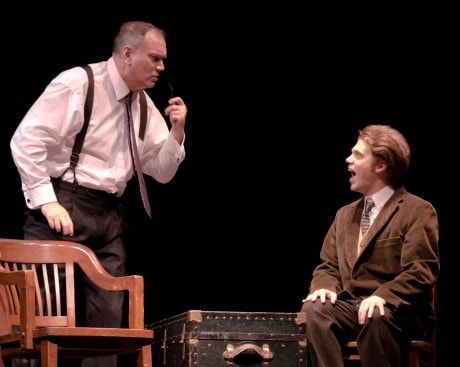The Little Theatre of Alexandria presents The Woman in Black, a haunting tale about an encounter between a rational man and a merciless spirit. Directed by Kristina Friedgen, this eerie play caught and held my attention from the get-go, and I’m sure its effect will linger with me for a long time.

The set, designed by Dan Remmers, is an interesting one. A gauzy veil is pulled across half of the stage, behind which certain scenes are played out and seen through a vague, shadowy glow. This includes a graveyard scene, as well as a child’s nursery, where a lone chair ominously rocks itself. A doorway sits on the other side of the stage, around which stand old-fashioned trunks, wooden chairs, and a coat rack.
It is the early 20th century in Britain, and costumes by Susan Boyd reflect this well, with suits and ties cut in a way that harken back to another era. On the coat rack hangs (you guessed it) coats, as well as aprons and a variety of hats. As one actor takes on many characters in this production, with just a simple and quick change of a piece of clothing, a new character is able to thrive. However, the most memorable costume belongs to the title character, whose gaunt face is partially hidden by a black bonnet and veil, and her body is cloaked in layers of dark material. The Woman in Black, indeed.
The lights rise on an elderly man named Arthur Kipps (Elliot Bales, who also takes on a variety of other roles) who is attempting to read a harrowing story from his memoirs that “must be told. I can carry this burden no longer.” Interrupting him every few seconds and chastising his performance and delivery is a hired actor (Erik Harrison, who also plays a younger Arthur Kipps) from whom Kipps hopes to receive advice. Arguing about how best to interest the audience, Kipps maintains that he does not want his story to turn into a “spectacle” or be seen as a form of entertainment, while his acquaintance insists that the best way to get an audience to listen is to intrigue them. They decide (Kipps most hesitantly) to make a performance of the story, with the hired actor performing the role of a younger Kipps, while the real Arthur Kipps takes on the rest of the characters.

Arthur Kipps, a young and happily engaged solicitor, is given an assignment to attend a client’s funeral and examine her paperwork in a far-off town. Once there, he discovers that the client was somewhat of a recluse, avoiding contact with the townspeople and staying in her isolated Eel Marsh House, which becomes completely blocked off from the town with the rising tides. The townspeople are not particularly welcoming, and even less so when they realize why Kipps is visiting. People shy away from him, and any mention of the house or its former inhabitant brings a tension-laced silence. Kipps is stricken when, at the funeral, he sees a Woman in Black (Erin Gallalee) with a “wasted face” standing in the shadows. She appears again, standing in the marsh outside of the house before vanishing as if from thin air. Arthur, a highly logical man, insists that he does not believe in ghosts. However, as he delves into the story of the house and the family that once lived there, he realizes the true horror that is The Woman in Black; a woman full of rage and vengeance, whose sightings ultimately bring disastrous results…a woman who has marked him.
The actors often jump in and out of the story to critique their own performances and do things such as add recorded sound (supplied by sound designer Alan Wray) and talk about special effects. This helps relieve some of the tension that is built up…but what happens when two seemingly separate stories, separated by decades, collide? In a chilling twist, we see that the Woman in Black’s work is not yet over.
Perhaps the best effect used in this performance is the lighting, designed by Ken and Patti Crowley. It creeps upon you, subtly hinting at a woman’s figure in the shadows and later, frenzied, bold, and flickering. It is this that makes the woman’s appearance so scary, and it is masterfully done. The actors all do an exceptional job as well, with Bales taking on multiple roles, each one more unique than the last, utilizing different accents, movements, and other differing traits such as a stutter. Erik Harrison is wonderful – his soft descriptive narrative and strong gaze lure you into the story and holds you there.
Entertaining, enthralling, and full of chilly surprises, The Woman in Black is a night of great entertainment!
Running Time: 90 minutes, without an intermission.

The Woman in Black plays through June 23, 2012 at The Little Theatre of Alexandria – 600 Wolfe Street, in Alexandria, VA. Order tickets by calling (703) 683-0496, or order them online.




